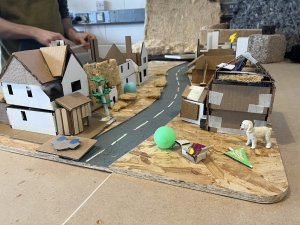The value of documentation
Author: Dr Gabriella Giannachi, Co-investigator, University of Exeter
So much of the funding that goes into research is aimed at the generation of products, be it articles, platforms, medical treatment, homes, virtual worlds, or other. Yet even though the process through which we may have arrived at generating a given product is just as interesting as the product itself, it often remains undocumented and/or unarchived. While there are unquestionable benefits in the production of archives that present the research to the public, it is worth revisiting exactly what should be placed in those archives. Rather than focus exclusively on the results of the research, I propose that process is documented by considering three key dynamics:
1) what the field looked like before, during and after the project;
2) the relationship with stakeholders and end-users;
3) interdisciplinary or even transdisciplinary learning that could be passed on to stakeholders, including industry, government, and the general public.
Broadly, a documentation should capture key information about a project (i.e. funder, interdisciplinarity, community focus, wellbeing, policy changes) as well as materials for possible public dissemination, be it through a film, exhibition, workshop or set of slides. For this, it is important to focus on whole life arc of a project (i.e. the whole project narrative using storytelling, photos, videos, text, installation, glossary, myth busting, impacts, etc.).
In relation to our Transforming Homes project, it was crucial to document the specific homes we worked with by capturing what they looked like, felt like, what stories they told, what heritage they entailed before we made plans to change them, as well as what happened to them during the project, and finally what model for future living they could present for others in years to come. To make sure stakeholder and end-user experiences were documented throughout, we felt it was important to document people’s expectations, fears as well as hopes, which revealed fascinating stories about how people used to live, actually live, and wish they could live. These stories were documented during interviews, charrettes and workshops which facilitated co-design throughout the different phases of the project. In terms of the creation of a retrofit toolkit, this will need to be targeted towards different stakeholders so that ad hoc recommendations could be tailored to specific contexts.
A key to building an understanding of the values of documentation is Suzanne Briet’s 1951 ‘Qu’est-ce que la documentation?’ (‘What is Documentation?’), whose findings show that documentation constitutes a form of production within the cultural sector. Briet proposed that a document is a ‘concrete or symbolic indexical sign [indice], preserved or recorded toward the ends of representing, of reconstituting, or of proving a physical or intellectual phenomenon’ (2006: 10). To her these include written letters, books, stones, or her famous example, an antelope. However, she also suggested making a distinction between primary, secondary, and auxiliary documents. The first is the initial document and the second provides information about the initial document. The third type derives from the assumption that documents are always part of and reflective of the context or network in which they appear. This distinction between different types of documents suggests that they can be used dynamically, not only as evidence or proof of something that occurred but also as prompts for actions that can acquire future value. The reason for this behaviour of documents is to be found in the function of archives, where documents usually end up residing (Giannachi, 2016).
The philosopher Jacques Derrida’s Archive Fever (1995) traced the word archive to Arkhe, indicating that archives constitute both ‘the commencement and the commandment’ (Derrida 1996, 1; original emphasis). The document then, like the archive that hosts it, entails both an ontological and a nomological principle, defining it as an entity with a point of origin, as well as the ordering principle that is consequently produced and propagated by it. Hence, what is documented persists not only as an example of an instance but also as the organizing principle of something yet to occur. Thus, for Derrida, ‘archivization produces as much as it records the event’ (17, original emphasis). Not only is the archive a tool for preservation, and a mechanism for dissemination, it is an ordering system for the production of knowledge within which documents and documentation play a key role.
Our primary documents – including measurements, criteria for the selection of bio-based materials, architectural plans, charrette and workshop plans, community engagement and events planning, and, especially, the voices of the people whose homes we retrofitted, as well as those of the stakeholders involved in the process – would need to be complemented by secondary and auxiliary documents providing the context of the work and offering an analysis of people’s final reactions to the retrofit so as to generate a framework providing stakeholders, including industry, government, and the general public, with a set of retrofit tools. The documentation produced by the project would then not only create a testimony capturing how the interdisciplinary team contributed to and learnt from the work but also produce an example as to how wider communities and stakeholders would benefit from it. Only then would the project archive truly offer a ‘commencement’ and ‘commandment’, to use Derrida’s terms, for the retrofitting of our homes.


Credits: Francis Moran
Works cited
Briet, S. (2006 [1951]) ‘What is Documentation?’, trans. Ronald E. Day and Laurent Martinet with Hermina Anghelescu, Lanham, MD: Scarecrow Press.
Derrida, J. (1996 [1995]) Archive Fever, tr. E. Prenowitz, Chicago: The University of Chicago Press.
Giannachi, G. (2016) Archive Everything. Mapping the Everyday. Cambridge, MA: The MIT Press.
